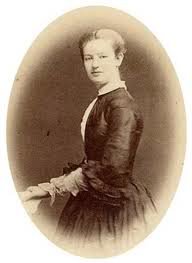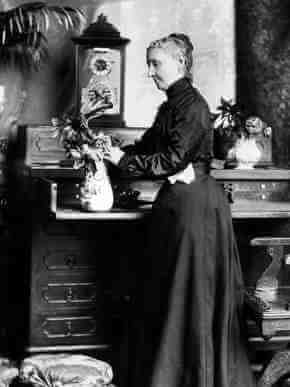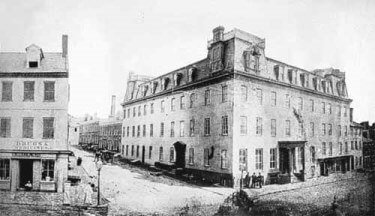Catherine Magill Dorman was born in Georgia on October 7, 1828. ‘Kate’ married Arthur Magill in 1844. Seven years later, the couple went to Texas, settling at the seaport community of Sabine Pass. She stood only 4 feet 10 inches tall, but folks learned quickly not to cross her.
In 1852, the young couple built an inn they called the Catfish Hotel, adjacent to the waters of the Sabine Pass. The hotel had its own wharf that extended into Sabine Lake from the front of the two-story building, so steamboats could dock and their crews could come in and eat dinner. By 1860, there were 24 permanent guests living in the hotel, as well as the itinerant seamen who lodged there and enjoyed the inn’s fine cuisine.
In addition to helping out at the hotel, Arthur Magill served as the engineer on the steamer T.J. Smith, a 100-foot mail packet operating out of Sabine Pass. On November 2, 1859, the vessel’s boiler exploded. Arthur Magill died in the accident, leaving Kate and her two young daughters alone in the small coastal community.
Kate seriously mourned the death of her husband, but she was not the kind of woman who liked living alone. In 1860, she married a widowed friend of her deceased husband, Captain John Dorman, who was master of the Neches River cotton steamer Doctor Massie.
Through it all, Kate continued to operate the Catfish Hotel. During the Civil War, what with blockade runners and a Confederate coastal artillery installation called Fort Griffin, Kate’s business improved.
But a great tragedy struck Sabine Pass in July, 1862, when a yellow fever epidemic was imported on a blockade runner, killing at least 100 and infecting dozens more. Very quickly, 90% of the population, about 1,000 persons, deserted the town, praying they and their families would not catch the dreaded disease.
But Kate Dorman and two friends, Sarah Vosburg and Sarah Ann King, did not leave. There was no medical facility anywhere nearby, so the three women turned the Catfish Hotel into a hospital, where they nursed at least 200 patients during the four-month epidemic. 100 civilians and 40 Confederate soldiers died during a four-month period. Fortunately, the three women were not infected.
In September 1862, three Union gunboats appeared and fired a few shells into the town. A party came ashore and burned the Confederate barracks and stable, appropriating from the Dormans a horse and cart to mount a howitzer they brought with them.
Kate saw what happened and did not like it much. As a Houston newspaper later reported, “Mrs. Dorman became enraged and gave them just such a tongue-lashing as only a brave woman would dare do.” Kate shook her fist at the Yankees, and said she hoped the Rebels killed them.
The Federal soldiers returned the confiscated horse and cart, but they had a warning for Captain Dorman:
Keep his damned wife’s mouth shut, [or] they would hang him. Mr. and Mrs. Dorman have a large hotel in the place, and the Yanks declare if she does not apologize to them, they will burn it. She declares she will see them in the lower regions first, and they may burn it if they choose.
A week later, another patrol came ashore and burned a quarter of Sabine Pass, including all of its shipyards, wood-working industries and several fine residences, but they left the Catfish Hotel and the Irish innkeeper alone. The Yankees abandoned Sabine Pass in January 1863.
A year later the Yankees returned, intending to land 4,000 troops in Texas. A four-vessel flotilla bombarded the Confederate fort, located only about 300 yards from the Catfish Hotel.
With Federal shells exploding all around, Kate worked over a hot stove in the hotel’s kitchen, making coffee and frying meat and doughnuts for the defenders. As the fight continued, she hitched up the horse and cart and rode to the fort to feed the artillerymen. To fortify their courage, she also delivered a gallon of whiskey.
In the subsequent altercation, 47 Irishmen and a Houston bartender held off the Federal invasion and put two gunboats out of commission, preventing a lot of bloodshed in Texas in the process.
The remainder of the war at Sabine Pass went much the way of other small towns. By May 20, 1865, Sabine’s defenders had abandoned their posts, and returned to their farms. On May 25, a small Union detachment came ashore and raised the Stars and Stripes over the fort, without incident.
Kate and John Dorman lived at Sabine Pass for the rest of their lives. Captain Dorman died there in July 1886, only three months before a hurricane destroyed the entire town. Kate was unharmed, of course.
Having survived the yellow fever epidemic, the Civil War, and the storm that killed 86 people, Kate Dorman passed on to her great reward on Christmas Eve, 1897. She has become known as the Heroine of Sabine Pass.





